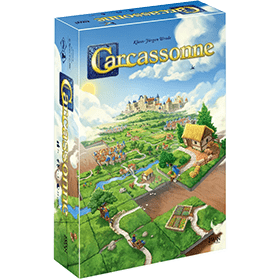Carcassonne
 Carcassonne on mäng, kus mängijad täidavad ruudukujuliste kaarditükkidega maa-ala ümber kindlustatud linna.
Carcassonne on mäng, kus mängijad täidavad ruudukujuliste kaarditükkidega maa-ala ümber kindlustatud linna.
Nad asetavad maha ruudukujulisi kaarditükke ja paigutavad oma alamaid teedele, linnadesse, kloostritesse ja põldudele.
Mängijad saavad punkte selle eest, kui nende alamad on objektidel, sel hetkel kui need objektid lõpetatakse. Mängija, kes paigutab oma kaarditükid ja alamad kõige strateegilisemalt, teenib kõige rohkem punkte ja võidab mängu.
Carcassonne võitis 2001. aastal tunnustatud Spiel des Jahres lauamänguauhinna ning on nüüd üks mängitumaid lauamänge kogu maailmas.
Mängijate arv: 2 - 5
Mängu kestus: 16 mn
Keerukus: 1 / 5
Mängi Carcassonne ja 1184 other games veebis.
Allalaadimine ei ole vajalik - mängi otse oma veebibrauseris.
Oma sõprade ja tuhandete mängijatega kogu maailmast.
Vaba. Tasuta.

Mängi Carcassonne ja 1184 other games veebis.
Allalaadimine ei ole vajalik - mängi otse oma veebibrauseris.
Oma sõprade ja tuhandete mängijatega kogu maailmast.
Vaba. Tasuta.

Reeglite kokkuvõte
Gameplay
The game board is a medieval landscape built by the players as the game progresses. The game starts with a single terrain tile face up and 71 others shuffled face down for the players to draw from. On each turn a player draws a new terrain tile and places it adjacent to tiles that are already face up. The new tile must be placed in a way that extends features on the tiles it touches: roads must connect to roads, fields to fields, and cities to cities.
After placing each new tile, the placing player may opt to place a meeple on a feature of that newly placed tile. The placing player may not use a meeple to claim any features of the tile that extend or connect features already claimed by another player. However, it is possible for terrain features claimed by opposing players to become "shared" by the subsequent placement of tiles connecting them. For example, two field tiles, each having a meeple, can become connected by another terrain tile into a single field shared by each meeple's player. If a shared feature is connected to yet another feature of the same type claimed by one of the same players, said player, now having more meeples in that feature, gains full claim over the feature.
When a feature other than a field is completed, all meeples in the completed feature are returned to the players who placed them, and can be reused. The player(s) with the most meeples in the feature score points immediately (see below).
The game ends when the last tile has been placed. At that time, all features (including fields) score points for the players with the most meeples on them. The player with the most points wins the game.
Scoring
During the players' turns, cities, monasteries (also known as cloisters) and roads (but not fields) are scored when they are "completed" — cities and roads when they are actually completed (i.e. contain no unfinished edges from which they may be expanded) and monasteries when they are completely surrounded by eight tiles. At the end of the game, when there are no tiles remaining, all incomplete features are scored. Points are awarded to the players with the most meeples in a feature.
If there is a tie for the most meeples in any given feature, all of the tied players are awarded the full number of points. In general (see table), points are awarded for the number of tiles covered by a feature; monasteries score for neighboring tiles; and fields score based on the number of connected completed cities.
Once a feature is scored, all of the meeples in that feature are returned to their owners.
| Feature | Completed during play | Game end |
|---|---|---|
| City | 2 points per tile + 2 points per pennant | 1 point per tile + 1 point per pennant |
| Road | 1 point per tile | 1 point per tile |
| Monastery | 1 point + 1 point per surrounding tile | 1 point + 1 point per surrounding tile |
| Fields | (Not scored) | 3 points for each completed city bordering the field. |
Expansions
The River
This expansion features a river which replaces the starting tile. The river starts from the source to the lake and cannot turn twice in the same direction.
Inns and Cathedrals
This expansion features inns (next to roads) and cathedrals (next to cities). Also, a large meeple of each colour is featured.
- Inns: If a road is completed with one or more inns, each tile scores 2 points instead of 1. However, an incompleted road with inns in the end does not score any points.
- Cathedrals: If a city is completed with one or more cathedrals. each tile and coat of arms scores 3 points instead of 2. However, an incompleted city with cathedrals in the end does not score any points.
- Large meeple: A large meeple is worth 2 meeples instead of 1.
Traders and Builders
This expansion features goods tokens, builders and pigs.
- Goods tokens: The person who finishes a city with goods collects the goods in the city. The goods are wine(9), grain(6) and cloth(5). At the end of the game, the player with the most goods token of a type scores 10 points. If multiple players tie, all get the full points.
- Builder: Each player has a builder. It can be placed on a road or city with at least one of your meeples. If you continue the feature with your builder on it, you get a double turn.
- Pig: Each player has a pig. It can be placed on a field with your farmer. The pig scores 1 point for each completed city in the field.
The Princess and the Dragon
This expansion features the dragon, the fairy and the magic portal.
- The volcano: The dragon appears on it. After the dragon appears, dragon tiles can be placed. No meeples can be placed on a volcano tile.
- Dragon tiles: Each player take turns to move the dragon until the dragon moves 6 spaces or is unable to move. All figures on the spaces it visits returns to their owners without scoring.
- The princess: Instead of placing a meeple, you can return a meeple in the city to their owner.
- The magic portal: You can place a meeple on any previous placed tile instead on the tile you placed.
- The fairy: It belongs to nobody. Instead of placing a meeple, you can move the fairy to one of your existing meeples. If the fairy is on one of your meeples at the start of your turn, you score 1 point. All figures on it are protected from the dragon. If a feature is scored while one of your meeples on it has the fairy, you score 3 points, even if you are not winning the feature.
Strategic Variant
Each player has 3 tiles at the start. On each turn, a tile is drawn and added to the player's hand. They choose which one to place each time.

